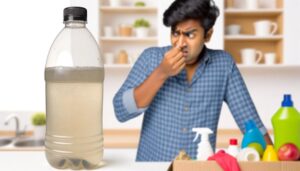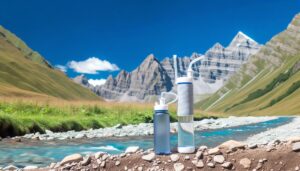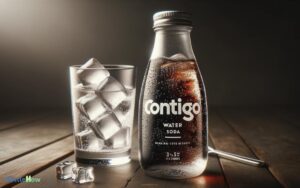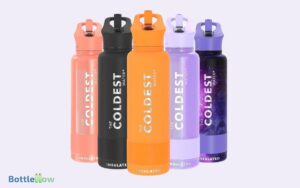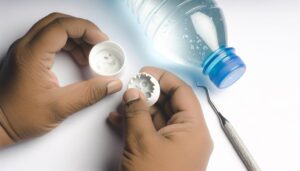Can You Put Hot Tea in a Plastic Water Bottle? Find Out!
You shouldn’t put hot tea in a plastic water bottle. When exposed to high temperatures, plastics like PET and HDPE can leach harmful chemicals such as BPA and phthalates into your drink.
These substances may disrupt hormones and increase cancer risk. Most plastic bottles aren’t designed to handle liquids above 60°C, which hot tea often exceeds.
Choose safer containers like stainless steel or glass, which are both heat-resistant and non-toxic.
To make sure you’re safeguarding your health and the environment, consider these effective alternatives and learn more about selecting the right materials.
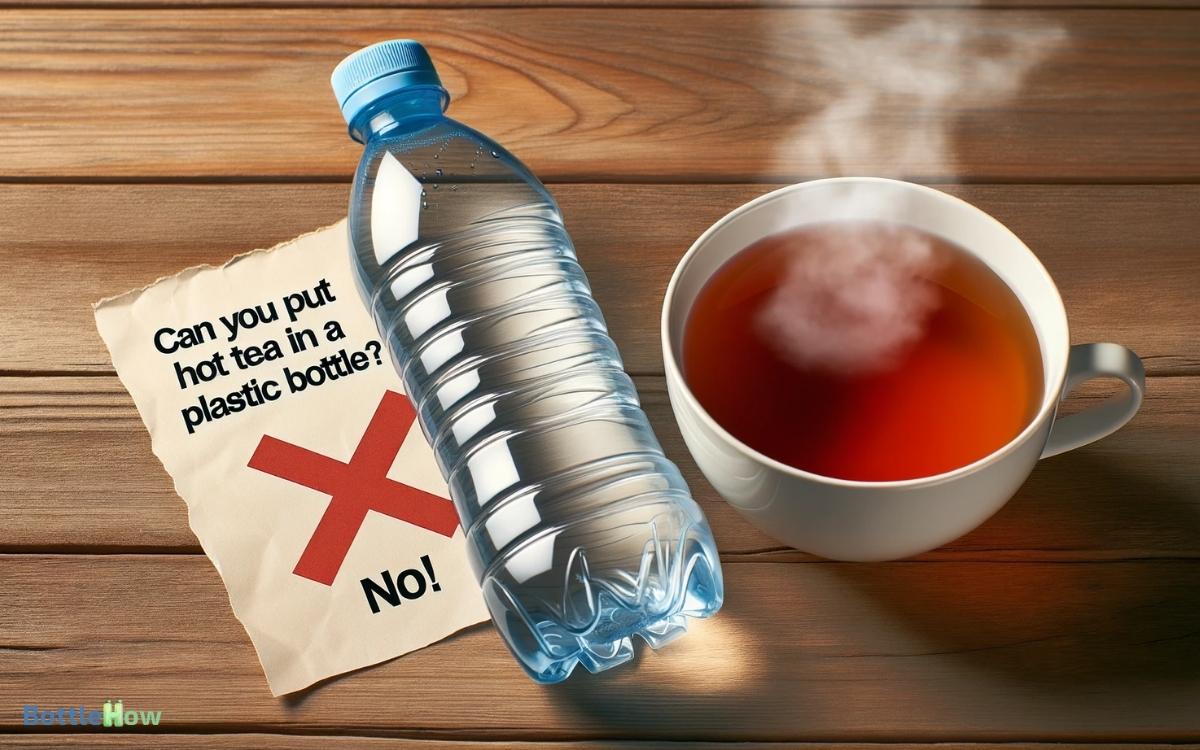
Key Takeaways
Types of Plastic
When considering whether to put hot tea in a plastic water bottle, it’s important to understand the different types of plastic and their heat tolerance.
Plastics like Polyethylene Terephthalate (PET) and High-Density Polyethylene (HDPE) are common in water bottles, but they have varying heat resistances.
PET, often used in single-use bottles, can warp at high temperatures, releasing harmful chemicals.
HDPE, more heat-resistant, is used in reusable bottles but still has limits. Bisphenol A (BPA) in some plastics can leach into hot liquids, posing health risks.
Always check the plastic identification code, usually on the bottom. Codes 1 (PET) and 2 (HDPE) have different uses and safety profiles, so recognize these distinctions to make an informed choice.
Plastic Water Bottles
Understanding the types of plastic helps you make safer choices about using plastic water bottles for hot tea.
Most plastic water bottles are made from PET (polyethylene terephthalate) or HDPE (high-density polyethylene). PET is common in single-use bottles, while HDPE is used in reusable ones.
Each type of plastic has a temperature threshold; PET can start to deform at around 70°C (158°F), while HDPE can handle slightly higher temperatures, up to about 110°C (230°F). However, heat can compromise the structural integrity of both.
You should also consider that plastics can release chemicals when exposed to high temperatures, affecting both your health and the taste of your tea. Always check the bottle’s label for heat resistance guidelines before use.
Chemical Leaching
When you pour hot tea into a plastic water bottle, you risk chemical leaching, where harmful substances like BPA and phthalates can seep into your drink.
Studies indicate that higher temperatures can exacerbate this process, increasing the likelihood of these chemicals entering your system.
Taking into account these factors, it’s essential to weigh the potential health risks before using plastic bottles for hot beverages.
BPA and Phthalates
Many plastic water bottles contain chemicals like BPA and phthalates that can leach into your hot tea, posing potential health risks.
BPA, or bisphenol A, is known to disrupt endocrine function, affecting hormone levels. Phthalates, often used to make plastic flexible, can also interfere with the endocrine system, leading to potential reproductive issues and developmental problems.
| Chemical | Source in Plastic Bottles | Potential Health Risks |
|---|---|---|
| BPA | Polycarbonate plastics | Endocrine disruption, hormone imbalance |
| Phthalates | Plasticizers in flexible plastic | Reproductive issues, developmental problems |
| Both | General plastic manufacturing | Overall increased risk with heat exposure |
Understanding these risks helps you make informed choices about using plastic bottles for hot beverages. Always opt for safer alternatives like stainless steel or glass to avoid chemical exposure.
Temperature Sensitivity Concerns
While plastic bottles may seem convenient, exposing them to high temperatures can greatly increase the risk of harmful chemicals like BPA and phthalates leaching into your hot tea.
When plastic is heated, its molecular structure becomes destabilized, allowing these chemicals to migrate into your beverage.
Studies have shown that even minimal exposure to high temperatures can cause significant leaching, making hot liquids particularly vulnerable.
You should also consider that not all plastics are created equal; some are more susceptible to temperature-induced chemical release than others.
Hence, it’s important to check the type of plastic your bottle is made from and whether it’s designed to withstand heat. Being informed about these aspects helps you make safer choices for your health.
Health Risk Factors
Understanding the health risk factors associated with chemical leaching is vital, as these harmful substances can migrate into your hot tea and pose serious health concerns.
When you pour hot tea into a plastic water bottle, the heat can cause chemicals like BPA (Bisphenol A) and phthalates to leach from the plastic.
Studies have shown that these chemicals can disrupt endocrine function, leading to hormonal imbalances, reproductive issues, and increased cancer risk. Research suggests that even small amounts of these substances can be harmful over time.
Using containers made specifically for hot liquids, such as glass or stainless steel, is necessary to prevent potential exposure to these dangerous chemicals. Your health depends on the choices you make every day.
Health Risks
When you put hot tea in a plastic water bottle, you risk the leaching of harmful chemicals like BPA, which studies have shown can disrupt hormones.
Additionally, plastic bottles aren’t designed to handle high temperatures, which can lead to structural instability and potential release of microplastics.
Considering these factors, it’s important to weigh the health risks before using plastic bottles for hot liquids.
Chemical Leaching Concerns
Heating plastic water bottles can cause chemicals like BPA and phthalates to leach into your hot tea, posing potential health risks.
Studies show that when plastic is exposed to high temperatures, it can release these harmful compounds.
BPA has been linked to various health issues, including hormonal disruptions and increased cancer risk.
Phthalates, often used to make plastics flexible, may affect your endocrine system, leading to developmental and reproductive problems.
While some plastics are labeled BPA-free, they might still contain other harmful chemicals that could leach out when heated.
To avoid these risks, it’s best to use materials like glass or stainless steel for your hot beverages, ensuring your health isn’t compromised by unseen chemical contaminants.
Temperature Stability Issues
Apart from chemical leaching, another significant concern is the temperature stability of plastic water bottles when exposed to hot liquids.
Most plastic bottles are designed for cold beverages and can warp or degrade when subjected to high temperatures. This instability can lead to structural failure, causing leaks or spills, which pose a safety risk.
Additionally, heating plastic can accelerate the release of harmful chemicals like BPA and phthalates, which are linked to various health issues, including hormonal disruptions and increased cancer risk.
Studies have shown that even heat-resistant plastics aren’t entirely safe, as they can still release microplastics.
For these reasons, it’s important to use containers specifically designed to withstand high temperatures when dealing with hot liquids.
Temperature Limits
Plastic water bottles have specific temperature limits, and exceeding these can lead to the release of harmful chemicals. Understanding the risks associated with high temperatures is crucial.
Most plastic bottles are designed for cold or room temperature liquids. Here are some key points to keep in mind:
- Melting Point: Most plastic bottles start to soften at around 70°C (158°F).
- Chemical Leaching: At temperatures above 60°C (140°F), harmful chemicals may leach into the liquid.
- Material Type: Different plastics have varying temperature tolerances. Check the type of plastic used (e.g., PET, HDPE).
- Manufacturer Guidelines: Always follow the manufacturer’s recommendations regarding temperature limits.
BPA and BPS Concerns
When you pour hot tea into a plastic water bottle, you could be exposing yourself to Bisphenol A (BPA) and Bisphenol S (BPS), chemicals linked to various health concerns.
BPA is known to disrupt endocrine function, potentially leading to reproductive issues, heart disease, and developmental problems in children.
BPS, often used as a BPA alternative, may pose similar risks. Studies suggest that heating plastic can increase the likelihood of these chemicals leaching into your beverage. Even if a bottle is labeled ‘BPA-free,’ it doesn’t guarantee safety, as it might contain BPS.
To safeguard your health, it’s crucial to understand these risks and make informed choices about the containers you use for hot liquids.
Alternative Containers
Considering the potential risks associated with plastic, exploring alternative containers for your hot tea becomes an essential step in safeguarding your health. Opting for safer materials can reduce exposure to harmful chemicals.
Here are four viable options:
- Stainless Steel: Durable and resistant to high temperatures, stainless steel keeps your tea hot without leaching chemicals.
- Glass: A non-toxic, BPA-free option that doesn’t retain flavors or odors, making it perfect for hot beverages.
- Ceramic: Often used for traditional teapots, ceramic containers are heat-resistant and safe for daily use.
- Silicone: Food-grade silicone is flexible, heat-resistant, and free from harmful additives, offering a modern alternative.
Switching to these containers ensures you’re making a health-conscious choice for enjoying your hot tea safely.
Environmental Impact
By choosing alternative containers for your hot tea, you’re not only protecting your health but also greatly reducing the environmental footprint associated with plastic waste. Plastics take hundreds of years to decompose, contributing greatly to pollution.
When you use materials like stainless steel or glass, you’re making a more sustainable choice. Evidence suggests these alternatives have lower life-cycle environmental impacts compared to single-use plastics.
Additionally, producing plastic bottles involves fossil fuels, leading to greenhouse gas emissions.
Reducing plastic use can mitigate these effects. While switching might seem small, collective actions can lead to substantial environmental benefits.
Opting for reusable, non-plastic containers supports a healthier planet and helps combat the pervasive issue of plastic pollution.
Reusability
Considering reusability, it’s crucial to weigh the benefits carefully:
- Durability: Stainless steel and glass are more robust, reducing the need for frequent replacements.
- Health Safety: Reusable containers avoid potential chemical leaching from plastics, especially when exposed to heat.
- Environmental Impact: Reusables contribute substantially less waste to landfills compared to single-use plastics.
- Cost Efficiency: Though the initial investment might be higher, long-term use saves money by eliminating the need for continual purchases.
Expert Opinions
Many experts caution against putting hot tea in plastic water bottles due to the risk of chemical leaching and potential health hazards. When exposed to high temperatures, certain plastics can release harmful chemicals into the liquid, which may pose health risks over time. This raises concerns for those who frequently store hot beverages in plastic containers. If you’re wondering, can you put flavor packets in hot tea, it’s important to check whether the packaging is designed to withstand heat without releasing unwanted substances.
When plastic is exposed to high temperatures, it can release harmful chemicals like BPA (bisphenol A) and phthalates into your drink.
These chemicals are linked to various health issues, including hormonal disruptions and increased cancer risk.
Studies have shown that even BPA-free plastics aren’t entirely safe, as alternative chemicals used in production may also pose risks.
Additionally, plastic can degrade more quickly when exposed to heat, affecting the bottle’s structural integrity.
Experts recommend using materials like stainless steel or glass, which are more stable and safer for hot liquids, to avoid these potential dangers.
Safety Tips
When considering safer alternatives to plastic for hot beverages, opt for materials like stainless steel or glass to minimize health risks.
Research shows that heating plastic can release harmful chemicals like BPA and phthalates, which may affect your health.
To guarantee safety, follow these tips:
- Choose BPA-free products: Look for bottles labeled BPA-free, though remember, this doesn’t eliminate all risks.
- Inspect for damage: Avoid using bottles with scratches or cracks, as they can leach more chemicals when heated.
- Avoid prolonged heat exposure: Don’t leave hot tea in the bottle for extended periods.
- Check temperature limits: Make sure the bottle is rated for hot liquids, as some plastics can’t handle high temperatures.
Practical Advice
If you must put hot tea in a plastic water bottle, make sure it’s specifically designed to handle high temperatures to avoid potential health risks.
Most standard plastic bottles are not built for heat and can release harmful chemicals when exposed to high temperatures.
Look for bottles made from materials like Tritan or food-grade silicone, which can withstand heat without leaching toxins.
| Material | Heat Resistance |
|---|---|
| Tritan | Up to 100°C (212°F) |
| Food-Grade Silicone | Excellent (Varies) |
| Common Plastics | Poor |
| Stainless Steel | Excellent |
Always check the manufacturer’s guidelines and avoid reusing old plastic bottles for hot liquids. This careful approach guarantees your hot beverage remains safe to drink.
Final Thoughts
Ultimately, ensuring your hot tea is stored safely in a suitable container is essential for both your health and enjoyment.
Plastic water bottles aren’t designed to handle hot liquids due to potential chemical leaching and structural degradation.
Here’s what you should consider:
- Material Safety: Use containers specifically marked as safe for hot beverages, like stainless steel or BPA-free plastic.
- Temperature Tolerance: Choose materials that can withstand high temperatures without deforming or releasing harmful substances.
- Health Risks: Be aware of the potential for chemical leaching from unsafe plastics, which can affect your health.
- Durability: Opt for containers that maintain their integrity, ensuring your tea remains enjoyable and safe to drink.
Conclusion
To sum it up, you shouldn’t put hot tea in a plastic water bottle. The heat can cause chemicals to leach into your drink, posing health risks.
Think of it like a snowball effect, where one small action leads to bigger problems. Stick to materials designed for hot liquids, like stainless steel or glass, to keep your tea safe and tasty. Remember, a little caution now can prevent a lot of trouble later.

